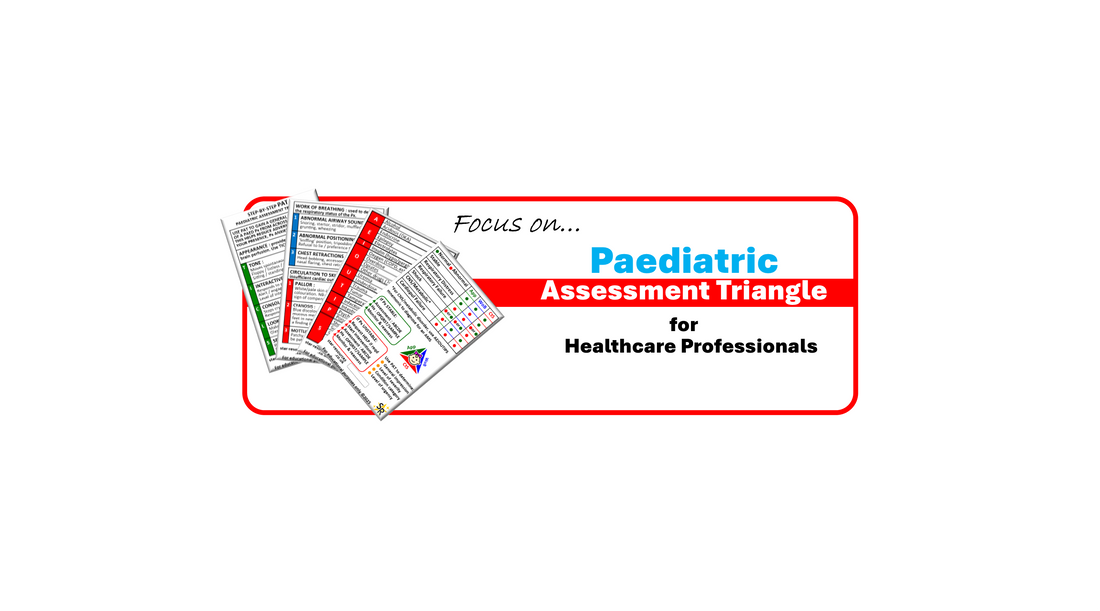
Focus On... Step-By-Step PAT (Paediatric Assessment Triangle)
Share
🩺 Mastering the Paediatric Assessment Triangle (PAT) – A Pocket Guide for Paramedics & Students
When it comes to assessing sick children, speed and accuracy are everything. The Paediatric Assessment Triangle (PAT) is one of the most widely taught and trusted frameworks in pre-hospital and emergency care. In under 30 seconds, it gives you a rapid impression of a child’s overall physiological status, helping you identify whether they are stable, in distress, or deteriorating quickly.
For student paramedics, EMTs, and clinicians working in high-pressure environments, remembering each element of the PAT during training or on shift can feel daunting. That’s where our Step-by-Step Paediatric Assessment Triangle Flashcards come in—a durable, pocket-sized reference designed for quick, clear decision-making.
🔹 What is the Paediatric Assessment Triangle?
The PAT is a hands-off, observational assessment tool recommended by Paediatric emergency experts. It focuses on three key areas:
- Appearance 👶 – Using the TICLS mnemonic (Tone, Interactiveness, Consolability, Look/Gaze, Speech/Cry) to evaluate neurological status and overall wellbeing.
- Work of Breathing 🌬️ – Assessing effort and effectiveness by observing retractions, nasal flaring, grunting, audible sounds, and positioning.
- Circulation to Skin ❤️ – Checking for signs of poor perfusion: pallor, cyanosis, mottling, or delayed capillary refill.
Together, these observations allow clinicians to rapidly categorise a patients presenting condition, including :
- Respiratory Distress
- Respiratory Failure
- Shock
- Cardiopulmonary Failure
This guides whether immediate intervention, urgent transport, or escalation of care is needed.
🔹 Why Carry a PAT Flashcard?
Whether you’re a student preparing for OSCEs or a clinician on shift, having a quick-reference tool can make all the difference.
✅ Always accessible – Credit-card sized, waterproof, and lanyard-ready.
✅ Boosts confidence – Reinforces learning until the PAT becomes second nature.
✅ Supports clinical decision-making – Clear prompts in moments of stress.
✅ Perfect for study and practice – Great for simulation, revision, and real-world use.

🔹 More Than Just PAT: AEIOUTIPS Included
Sometimes, a child presents with an altered mental state while their Work of Breathing and Circulation look normal. In these cases, the AEIOUTIPS mnemonic helps clinicians think through possible metabolic, neurological, or toxicological causes such as hypoglycemia, infection, or trauma.
Our flashcard includes both PAT and AEIOUTIPS, making it a comprehensive pocket tool for Paediatric assessment.

🔹 Who Is It For?
This flashcard is designed for:
- 🚑 Paramedics & EMTs – on the road, in the ED, or in training.
- 👩⚕️ Nurses – especially those in Paediatric, ED, or urgent care.
- 📚 Students – paramedic science, nursing, and medical students preparing for exams.
- 🏥 Simulation & training environments – OSCE practice, scenario drills, and skills labs.
🔹 Final Thoughts
The Paediatric Assessment Triangle is one of the most vital tools in Paediatric emergency medicine. With our PAT Flashcard, you’ll always have a reliable, quick-reference guide right at your fingertips—whether you’re learning, revising, or in the middle of a critical situation.
👉 Check out the PAT Flashcard here: Paediatric Assessment Triangle Flashcard
✨ Be prepared. Be confident. Be clinical.
